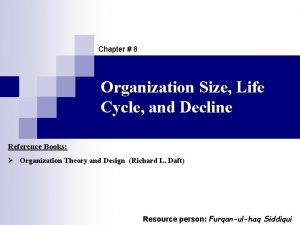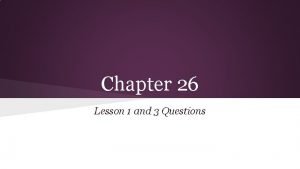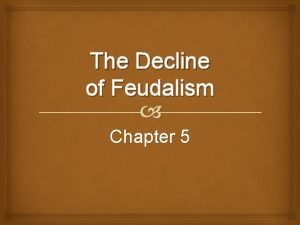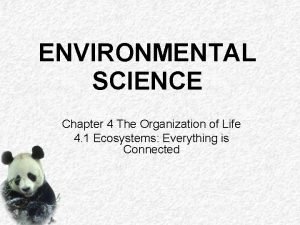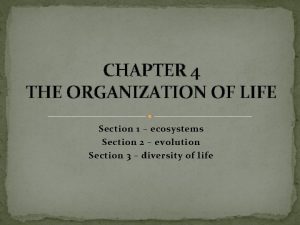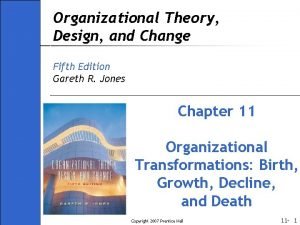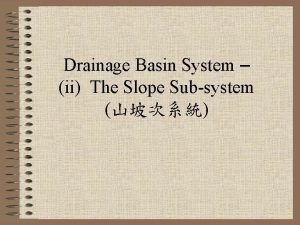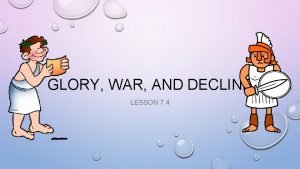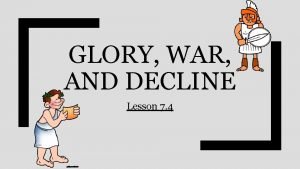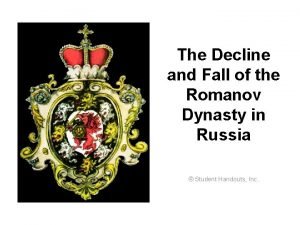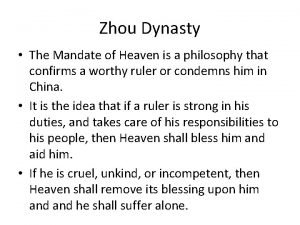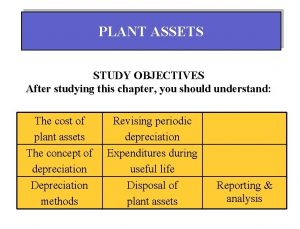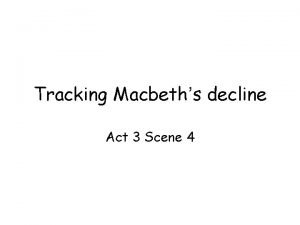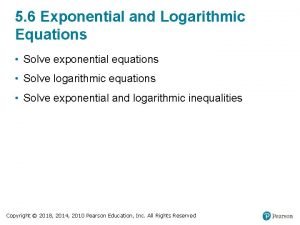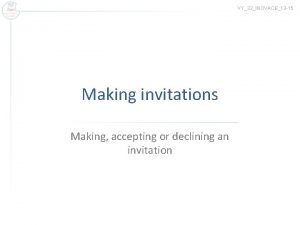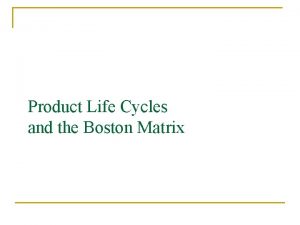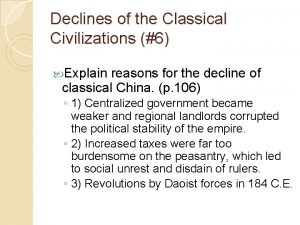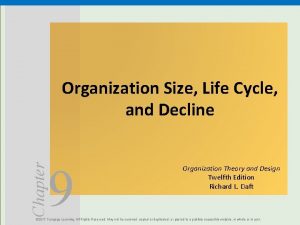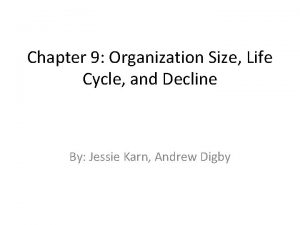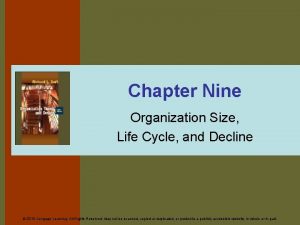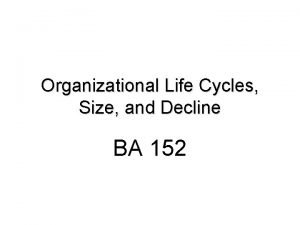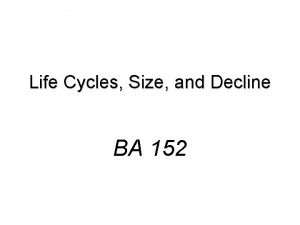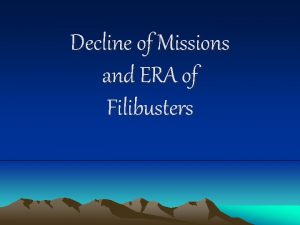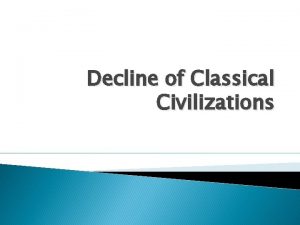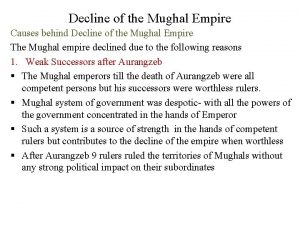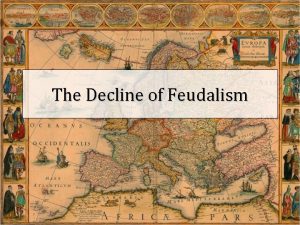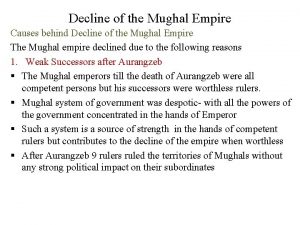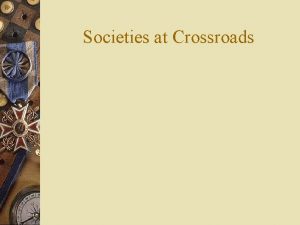Chapter 4 Organization Size Life Cycle and Decline












































- Slides: 44

Chapter # 4 Organization Size, Life Cycle, and Decline Reference Books: Ø Organization Theory and Design (Richard L. Daft) Resource person: Furqan-ul-haq Siddiqui



n Lesson: That’s a lot of churning and creative destruction, and it’s probably safe to say that almost all of today’s Fortune 500 companies will be replaced by new companies in new industries over the next 59 years, and for that we should be thankful. The constant turnover in the Fortune 500 is a positive sign of the dynamism and innovation that characterizes a vibrant consumer-oriented market economy, and that dynamic turnover is speeding up in today’s hyper-competitive global economy. Steven Denning pointed out a few years ago in Forbes that fifty years ago, the life expectancy of a firm in the Fortune 500 was around 75 years. Today, it’s less than 15 years and declining all the time.

n Aquihiring- buy out (a company) primarily for the skills and expertise of its staff, rather than for its products or services. n Acqui-hiring has become increasingly common in startup companies, especially within the competitive technology sector; as of March 2013, Facebook was the largest performer of talent acquisitions, with 12 over the last five fiscal quarters. Twitter, Yahoo!, and Google rank alongside Facebook as similarly major users of talent acquisitions.


Organization Size: Is Bigger Better? Large n Every entrepreneur dreams to have his or her company grow fast and grow large, maybe even to eventually make the Fortune 500 list. ¨ Industry consolidation, global expansion, and diversification have made firms grow ¨ Size enables companies to take risks ¨ R&D ¨ Growing organizations are vibrant, exciting places to work, which attract and keep quality employees. ¨ “to stop growing is to stagnate and die”.

Dilemmas of Large Size n Organizations feel compelled to grow, but how much and how large? What size organization is better poised to compete in a fast-changing global environment? ¨ Large organizations can get back to business more quickly following a disaster ¨ Large companies are standardized, mechanistic, and complex ¨ Large organizations give employees a sense of security and belonging during an uncertain time.


q Small Ø Ø Ø Organizations Small scale can provide significant advantages in terms of quick reaction to changing customer needs or shifting environmental and market conditions Small organizations often enjoy greater employee commitment. Employees typically work on a variety of tasks rather than narrow, specialized jobs. Many large companies have grown even larger through merger or acquisition in recent years, yet research indicates that few of these mergers live up to their expected performance levels. By default, Small organizations are more innovative. By some estimates, 90 percent of mergers never live up to expectations.

Differences Between Large and Small Organizations

, s e i t e i c o s e v i t i m i r p d f n a o , s s e i n d o i u t t a s z i n n o a d g r e r s o a b y n r a u t n Ba i D l i n i m b , s o t R c e t s s i g o l o p y o n r religious a h t r n o a f , e s z e i s s s e m n i u s m u i t p o e h s some b t y s a i s 0 r a 5 b 1 n t u a h D t. l d a e s o g a e propo v s e s i e h n c e a v i o t t c g e f n f i e y r s t ’ p p u , o s r e grou g r u e d h t e c e, o r z i p s , t s a e l h t u r y n a s m p beyond a o s o t d f n o a e n s w u a o c d e s b g n i 8 h t 1. t s wanes n w e o l m s t i t a m h t m o e c p a d t n a , m s a and red i s u h t n e , e l a r o m p u gro

The paradox is that the advantages of small companies sometimes enable them to succeed and, hence, grow large. Ø Small companies can become victims of their own success as they grow, shifting to a mechanistic structure emphasizing vertical hierarchy and spawning “organization men” rather than entrepreneurs. Giant companies are “built for optimization, not innovation. ” Ø q. Small or big? ? ? ? ?



Ø Ø 3 M Company, officially known as the Minnesota Mining and Manufacturing Company is an American multinational conglomerate corporation. With over 76, 000 employees (with 6000 Scientists) they produce over 55, 000 products, including: adhesives, abrasives, laminates, passive fire protection, dental products, electrical materials, electronic circuits and optical films 3 M has operations in more than 60 countries – 29 international presence with manufacturing operations, and 35 with laboratories. Company allows all employees to spend 15% on working projects of their own interest.

Ø Ø Ø 3 M is a multinational powerhouse, with more than $20 billion in annual sales across a product line 55, 000 deep. It boasts 22, 800 patents, many derived from its 15 percent program. The program has been key to 3 M's business strategy and could be a model for other companies eager to innovate. Says Kurt Beinlich, a technical director for 3 M: "It's really shaped what and who 3 M is. " On July 20, 1969, the first man on the moon is myth—it was the first shoe on the moon. Those shoes—Neil Armstrong's boots (size 9 1⁄2 medium) —are still on the moon, along with nine other pairs of boots worn during the Apollo missions 17

Big-Company/Small-Company Hybrid n The solution is what Jack Welch, retired chairman and CEO of General Electric, called the “bigcompany/small-company hybrid” that combines a large corporation’s resources and reach with a small company’s simplicity and flexibility. ØDivisional n Structure (SBUs) Johnson & Johnson is actually a group of 250 separate companies operating in fifty-seven countries.


Stages of Life Cycle Development A useful way to think about organizational growth and change is the concept of an organizational life cycle. n Entrepreneurial Stage- When an organization is born, the organization is informal and nonbureaucratic. The hours of work are long. Control is based on the owners’ personal supervision. Growth is from a creative new product or service. Crisis: need for leadership n Ø When Apple began a period of rapid growth, A. C. Markkula was brought in as a leader because neither Jobs nor Wozniak was qualified or cared to manage the expanding company.

n Collectivity Stage- If the leadership crisis is resolved, strong leadership is obtained and the organization begins to develop clear goals and direction. Departments are established along with a hierarchy of authority, job assignments, and a beginning division of labor. In the collectivity stage, employees identify with the mission of the organization and spend long hours helping the organization succeed. Members feel part of a collective. Communication and control are mostly informal although a few formal systems begin to appear.

Crisis: need for delegation n Top managers want to make sure that all parts of the organization are coordinated and pulling together. The organization needs to find mechanisms to control and coordinate departments without direct supervision from the top. n

ly k c i u q d e v o m k o o b e c a F y n a p m o c g n i. k e r g o a t w s t e y n t i l v a i i t c e l l o n Soc c e h t o t l ia r u e n e r p g r e t b n r e e k e c h t u Z m k r fro a M r e d n u o f d l o r a e y t e e e n r r h e t t n y I t n t e a w p u T w o r g “ o t s a h y n a p m , o e c v i s t i u h c e x e e l knows g o o G p o t a d e t i u. r r c e e c i r f f e o h g o s n i t ” , a r d e p o spee f e i h c s a e v r e s o t , g r e b o t d s e v i t u c e x e Sheryl San d e l l i k s r e h t o d e r , i l h a g o e s l l , a g k n i o t o e k r a m Faceb s a h c u s s n o i t c n u f. e s c u n o i a r n a i f v d e n g a a , s n man o i t a l e r c i l b u p d n a s n o i t a c i commun

n Formalization Stage- The formalization stage involves the installation and use of rules, procedures, and control systems. Communication is less frequent and more formal. Engineers, human resource specialists, and other staff may be added. Top management becomes concerned with issues such as strategy and planning and leaves the operations of the firm to middle management. Product groups or other decentralized units may be formed to improve coordination. collaboration/teamwork Crisis: Too much red tapes

n Elaboration Stage- The solution to the red tape crisis is a new sense of collaboration and teamwork. Social control and self-discipline reduce the need for additional formal controls. Managers learn to work within the bureaucracy without adding to it. Formal systems may be simplified and replaced by manager teams and task forces. To achieve collaboration, teams are often formed across functions or divisions of the company. The organization may also be split into multiple divisions to maintain a small-company philosophy Crisis: Need for revitalization

n n After the organization reaches maturity, it may enter periods of temporary decline. A need for renewal may occur every ten to twenty years. The organization shifts out of alignment with the environment or perhaps becomes slow moving and over bureaucratized and must go through a stage of streamlining and innovation. Top managers are often replaced during this period. At Apple, the top spot changed hands a number of times as the company struggled to revitalize. Steve Jobs returned in mid-1997 to run the company he had founded nearly twenty-five years earlier. Jobs quickly reorganized the company, weeded out inefficiencies, and refocused Apple on innovative products for the consumer market.

Organizational Life Cycle

Organization Characteristics During Four Stages of Life Cycle

Organizational Size, Bureaucracy, and Control n As organizations progress through the life cycle, they usually take on bureaucratic characteristics as they grow larger and more complex. Ø Weber defined bureaucracy as ─ a threat to liberty ─ the most efficient system for organizing ─ rational control ─ a new form of organization Bureaucracy includes: ¨ Rules and standard procedures ¨ Clear tasks and specialization ¨ Hierarchy of authority ¨ Technical competence Ø

Weber’s Dimensions of Bureaucracy

Size and Structural Control In the field of organization theory, organization size has been described as an important variable that influences structural design and methods of control. i. Formalization – rules, procedures, and written documentation ii. Centralization – level of hierarchy with authority to make decisions iii. Personnel Ratios – clerical and professional support staff ratios n

Percentage of Personnel Allocated to Administrative and Support Activities

Bureaucracy in a Changing World Ø Bureaucracy worked for the industrial age and widely practiced today. Ø Contemporary Organizations face new challenges and need to respond quickly. The bureaucratic system no longer works best for today’s challenges. Ø Over-bureaucratization is evident in the inefficiencies of large organizations Ø Narrowly defined jobs and rules limit creativity, flexibility, and rapid response n “Every time you add a layer of bureaucracy, you delay the movement of information up the chain of command. . . And you dilute the information because at each step some details are taken out, ”

Organizing Temporary Systems This approach is often used by organizations such as police and fire departments or other emergency management agencies to maintain the efficiency and control benefits of bureaucracy yet prevent the problem of slow response. Ø The approach is being adapted by other types of organizations to help them respond quickly to new opportunities, unforeseen competitive threats, or organizational crises. Ø

Organizational Decline and Downsizing The decrease of an organization’s resources over time is caused by usually following reasons: ¨ Organizational atrophy- when successful organizations grow older and become inefficient and overly bureaucratized. Often, atrophy follows a long period of success, because an organization takes success for granted, becomes attached to practices and structures that worked in the past, and fails to adapt to changes in the environment. Complacency. ¨ Vulnerability- Vulnerability reflects an organization’s strategic inability to prosper in its environment. Vulnerable organizations typically need to redefine their environmental domain to enter new industries or markets. ¨ Environmental decline or competition-

Stages of Decline and the Widening Performance Gap 36

A Model of Decline Stages i. iii. Blinded stage – internal and external changes cause the firm to tighten up. If the firm is not careful it will miss signs that will truly show them how to fix the problem. The organization may have excess personnel, cumbersome procedures, or lack of harmony with customers. Inaction stage – leadership ignores the obvious signs that there is a problem in the organization. “All is well” and “Creative accounting”. The solution is for leaders to acknowledge decline and take prompt action. Faulty action stage – at this stage, problems cannot be ignored. Retrenchment occurs. An organization can at this point make wrong decisions very easily.

iv. Crisis stage – chaos sets in at this point because the organization has not figured the problem. Major changes in the organization need to take place at this point. such as replacing top administrators and revolutionary changes in structure, strategy, and culture, are necessary. Workforce downsizing may be severe. Dissolution stage – This stage of decline is irreversible. The organization is suffering loss of markets and reputation, the loss of its best personnel, and capital depletion. the organization is so bad that the best course is the shut it down.




Retrenchment Defined • Regrouping through cost and asset reduction to reverse declining sales and profit Example • • PTCL’s operating profit decreased by 32 per cent in 2007 as compared to 2006 which became the reason of retrenchment of employees. KSC HBL PIA 42

Divestiture Defined §The next edition of the Oxford English Dictionary, the word reference bible of the English language, may never appear in print and instead be accessible only online (August, 2010) • Selling a division or §Nokia mobile phone business was eventually part of an organization. bought by Microsoft in an overall deal totaling € 5. 44 billion (US $7. 17 billion). Stephen Elop, Nokia's also known as former CEO, and several other executives joined the new Microsoft Mobile subsidiary of Microsoft as part divestment of the deal, which was completed on April 25, 2014. Example • On 30 March 2004, Unilever Pakistan accepted the offer of Rs. 1. 33 billion for the sale of its "Dalda" brand to Dalda Foods (Pvt. ) Limited, a separate company. . 43

Defined • Liquidation is an event that usually occurs when a company is insolvent, meaning it cannot pay its obligations as and when they come due. The company's operations are brought to an end, and its assets are divvied up among creditors and shareholders, according to the priority of their claims. Most common in partnership enterprises 44
 Organizational life cycle stages
Organizational life cycle stages Decline stage of fashion cycle
Decline stage of fashion cycle Chapter 7 lesson 4 glory, war, and decline answers
Chapter 7 lesson 4 glory, war, and decline answers Chapter 26 lesson 1 the decline of the qing dynasty
Chapter 26 lesson 1 the decline of the qing dynasty The decline of feudalism chapter 5 answer key
The decline of feudalism chapter 5 answer key Chapter 5 principles of engine operation
Chapter 5 principles of engine operation Point-by-point organization
Point-by-point organization Chapter 4 the organization of life
Chapter 4 the organization of life Chapter 4 the organization of life section 1
Chapter 4 the organization of life section 1 Weitzel and jonsson’s model of organizational decline
Weitzel and jonsson’s model of organizational decline Free face slope
Free face slope Glory war and decline
Glory war and decline Glory war and decline
Glory war and decline Glory war and decline
Glory war and decline The decline and fall of the romanov dynasty
The decline and fall of the romanov dynasty Class dd
Class dd Equipment of size separation
Equipment of size separation Process organization in computer organization
Process organization in computer organization Chapter 17 the beginning of the life cycle
Chapter 17 the beginning of the life cycle Chapter 19 section 2 the life cycle of stars answer key
Chapter 19 section 2 the life cycle of stars answer key Mandate from heaven
Mandate from heaven Orange order membership
Orange order membership Why did the dutch republic decline
Why did the dutch republic decline What is the maturity stage of the product life cycle
What is the maturity stage of the product life cycle Voici que la saison victor hugo
Voici que la saison victor hugo Units of activity method
Units of activity method Long lived tangible assets
Long lived tangible assets Declining balance method
Declining balance method Cabined cribbed confined
Cabined cribbed confined Airline reservations typically decline after
Airline reservations typically decline after Davis slope decline theory
Davis slope decline theory Qing dynasty decline
Qing dynasty decline Solve logarithmic equations
Solve logarithmic equations Why did egypt fall
Why did egypt fall Birthday invitation dialogue
Birthday invitation dialogue Russia 1450
Russia 1450 Reason for the decline of feudalism
Reason for the decline of feudalism Decline of the papacy
Decline of the papacy Product life cycle boston matrix
Product life cycle boston matrix Gary fish maine
Gary fish maine What caused the decline of classical civilizations
What caused the decline of classical civilizations Varvae
Varvae Is ea id chart
Is ea id chart Clumped dispersion
Clumped dispersion Sensory decline
Sensory decline
